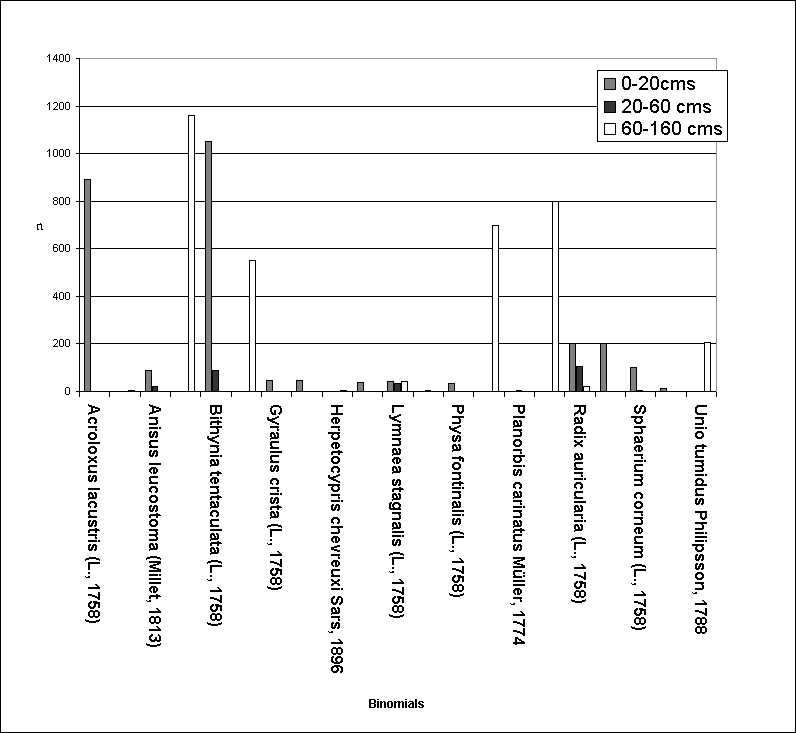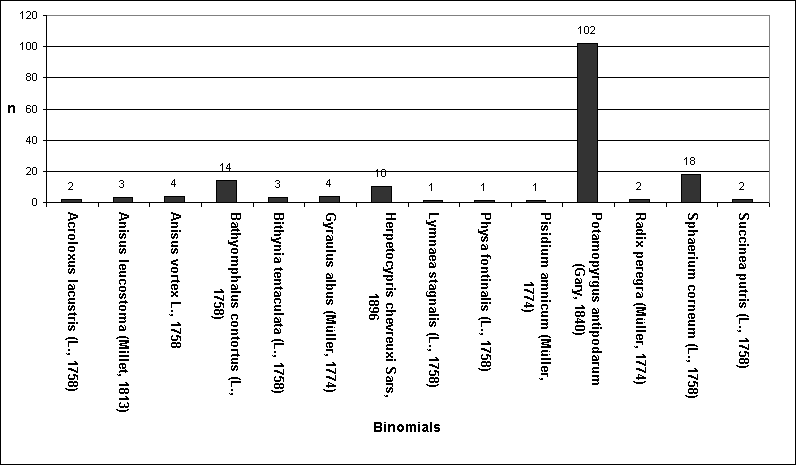
Worcestershire Record No. 24 April 2008 pp. 25-27
P. F. Whitehead
Introduction
The biota of the tributary streams of the River Stour that rise to the north-east of Kidderminster is interesting due to major anthropogenic impacts to their regimes. The streams, which drain Bunter Sandstones, consequently frequently have sandy beds, and eventually join the River Stour to the north of Kidderminster. I was first invited to visit the Hurcott Pool area of Churchill and Blakedown on 26 April 1980. The pool sits in a shallow valley and is mostly wooded to its margins at about 45 m O.D., the valley sides attaining 85 m or so in places.
The River Stour tributary stream that feeds Hurcott Pool has a long-extended history of management, most notably during the seventeenth century when water-powered mills and forges were a feature of the tributaries. Hurcott is cited as an early medieval berewick of Kidderminster, and its role and contribution to rural economy was certainly significant by then. At the end of the nineteenth century Hurcott Pool and other nearby pools were systematically dredged by traction engines working in tandem (anon., pers. obs., April 1980), and such management practices had presumably been in place for some time. A water bailiff was engaged during the twentieth century.
During the early spring of 1981, the sluices that held back the waters of Hurcott Pool were knocked out and the resultant fall in water level, by at least 1.6 m, reduced the surface area of the pool from about 53000 m2 to about 39000 m2. The rapid loss of such a volume of water provided no opportunity for aquatic molluscs to retreat, and the sequentially zoned habitats in the hydrosphere were immediately lost. It also prevented resident Great Crested Grebes from breeding, and Tufted Ducks abandoned the site.
I visited Hurcott Pool on 17 April 1981, and walked out from its margin on the south side for a distance of 16 m to the new water level, identifying stranded molluscs within reach of either side of the walked line, the total area covered being about 16 m2. The transect passed through rich fen and marsh communities, upper reed swamp dominated by Carex acutiformis Ehrh., with a water depth of 2-20 cm, lower reed swamp dominated by Typha latifolia L. with a water depth of 30-60 cm and then to open water up to 1.6 m deep with Nuphar lutea (L.) Smith. The width of the upper reed swamp was 2.5 m, of the lower reed swamp 5 m, and of the open water Nuphar zone 8.5 m. The bed of the pool consisted of >65 cm of coarse buff sand covered by up to 33 cm of glutinous black organic silt with plant detritus, foliage, twigs and branches in various stages of decomposition, amongst which were observed a few melanic frogs Rana temporaria (L.). Fig 1 represents the mollusc and ostracod fauna of the reed swamp and open water zones. Sampling difficulties were encountered from the mid-open water zone down, due to the presence of many small ostracod valves, mostly hinged, and small Pisidium shells, held in a matrix of glutinous sludgy organic silt impossible to manipulate in the field. The numbers of ostracods shown in Fig. 1 are extrapolated, roughly, from counts (hinged valves and separated valves divided by two) from a bulk sample of 100 gm of this silt washed through fine sieves. The Pisidium were not identified but represented only one or two species.
A spot sample from the bed of the feeder stream 450 m upstream of Hurcott Pool was also collected and its mollusc and ostracod fauna compared with that of the pool.
Observations on the lacustrine fauna of Hurcott Pool (Fig. 1)
The mollusc fauna of the reed swamp zones is composed of a number of typical species of catholic tastes, often tolerant of restricted habitats or reduced oxygen levels. The numbers of the freshwater limpet Acroloxus lacustris no doubt increased from their ability to cling to submerged twigs and branches from trees overhanging the shallower water, the network of which it preferred. The large gastropod Lymnaea stagnalis was one of only two species (Fig. 1) occurring across all water depths, but only juveniles were observed in the reed swamp; there was no field evidence to imply that exposed adults had been predated, and many of the stranded molluscs died slowly in situ. Although L. stagnalis is a pulmonate air-breathing species it is able to respire cutaneously in deeper water.
The deeper water was dominated by the widespread bivalve molluscs Anodonta cygnea and Unio pictorum, the larvae of which are fish parasites. Adults burrow into organic sediments which is why they prefer still or slow-moving water bodies. Most of the species of molluscs imply hard water.
The more intrinsically interesting species included large numbers of mud-dwelling ostracods in the open water zone. Those of the genus Candona prefer organic silty muds amongst which Candona neglecta is a relatively deep water 'cool climate' species, in reality probably intolerant of rapidly vacillating water levels. Pseudocandona rostrata is associated with submerged macrophytes, in this case Nuphar lutea. The large Herpetocypris chevreuxi is a clambering species which has been found, for example, in lily-ponds in Oxford (Dr E. Robinson, in litt., 24 April 1981), and is largely intolerant of moving water. Interestingly, it has a long-extended history in the region with records extending back in time 120,000 years (P.F. Whitehead, pers. obs.). Unsurprisingly, the pulmonate gastropods are scarce in the deeper water, and the relative frequencies of Radix auricularia (Fig. 1) reflect this. The total absence of the widespread gill-bearing gastropod Valvata piscinalis (Müller) is noted, as is the absence of ostracods from the reed swamp zones, although small numbers of their often very small valves would have been overlooked if buried.

Fig.1. Hurcott Pool, Churchill & Blakedown, 17 April 1981. Molluscs and ostracods (C. neglecta, P. rostrata) from three water depths: reed swamp 0-60 cm overall divided into two depths (grey and black columns), and open water 60-160 cm with Nuphar lutea (white columns). Arrangement is alphabetical by genus.
Observations on the fluvial fauna (Fig. 2)
The removal of the sluices also impacted on the flow regime of the shallow feeder stream, originating in the Clent Hills west of Birmingham. The stream was devoid of aquatic vegetation at the sample point, and had resorted its bed sediments and rafted coarse sand and shells against wood lodged in its bed. A sample of the coarse sand was collected and passed through fine sieves until 60 gms of dry material remained, the mollusc and ostracod evidence being retained for identification. The limited fauna lacks diversity and is of the expected type; the ostracod Herpetocypris chevreuxi probably derived from emergent herbage in quieter or humanly modified locations along the stream's sinuous course. Pisidium amnicum, which prefers basic, clean, running water is represented by one juvenile shell, whilst Potamopyrgus antipodarum, a now widespread nineteenth century introduction, dominates the fauna. The absence of Valvata spp. reflects the scarcity of well-developed aquatic vegetation in the stream and the total absence of small Pisidium spp. in the sample is noted.

Fig.2. Churchill & Blakedown, 17 April 1981. Molluscs and ostracods (H. chevreuxi) from sandy bed of Hurcott Pool feeder stream. Arrangement is alphabetical by genus.
Conclusion
Although the Pisidium fauna of Hurcott Pool was not studied in detail (Fig. 1) the fluvial Pisidium amnicum and Potamopyrgus antipodarum found in its feeder stream do not occur there. The absence of small Pisidium spp. in the stream sample has been noted and, in contrast to the pool, Bithynia tentaculata is poorly represented. No large unionids occur in the stream fauna. The two faunas therefore, existing some 450 m apart, mirror the changes in flow rate, bed conditions and vegetation between the primary fluvial and secondary lacustrine man-made biotope developed from it. The increase in numbers of herbivorous molluscs in the pool, especially the planorbids and lymnaeids, reflects positively on anthropo-impacts in this instance, as does the proliferation of more or less exclusively mud-dwelling or lacustrine ostracods.
Footnote on marginal communities
The terrestrial systems flanking Hurcott Pool are also of some interest including woodland, carr and fen communities with their characteristic plants including Cruciata, Ribes rubrum L., Lamiastrum, Chrysoplenium and Caltha. On 17 April 1981 the carr supported the predatory carabid beetles Carabus nemoralis Müller and Cychrus caraboides (L.), and the arionid slug Arion silvaticus Lohmander.
Acknowledgements
In addition to people mentioned in the text I thank Mr H.J. Davies of Wyre Forest District Council and Mr P. Dwight of Kidderminster Museum, for comment on the medieval history of the River Stour valley area. I also thank the landowners for permission to visit the site.
| WBRC Home | Worcs Record Listing by Issue | Worcs Record Listing by Subject |